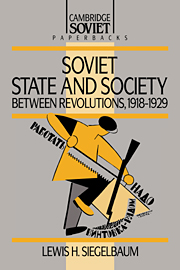Book contents
3 - The perils of retreat and recovery
Published online by Cambridge University Press: 06 January 2010
Summary
It is not we who are directing the new economic policy; just the opposite; the new economic policy is directing us.
(A. Sviderskii, Pravda, 24 November 1921)Where and how we must now restructure ourselves, reorganize ourselves, so that after the retreat we may begin a stubborn move forward, we still do not know.
(Lenin, “Speech at a Plenary Session of the Moscow Soviet, 20 November 1922,” PSS, vol. 45, p. 302)The decision of the Tenth Party Congress to abandon razverstka in favor of a tax-in-kind is normally associated with the inauguration of the New Economic Policy, and I have already referred to the tax as NEP's founding charter. But this is a retrospective view that does not account for the tentative and piecemeal nature of subsequent decrees. Rather than the product of purposeful planning, we would do better to see NEP as emerging on the basis of unexpected contingencies and the policy-makers' attempts to adapt to unforeseen circumstances.
This is not to say that there was no strategy, that NEP was simply the sum of its parts or that those parts bore no relation to each other. In speaking of the tax-in-kind and defending other new policies, Lenin repeatedly resorted to the military metaphor of “retreat.”
- Type
- Chapter
- Information
- Soviet State and Society between Revolutions, 1918–1929 , pp. 85 - 134Publisher: Cambridge University PressPrint publication year: 1992

